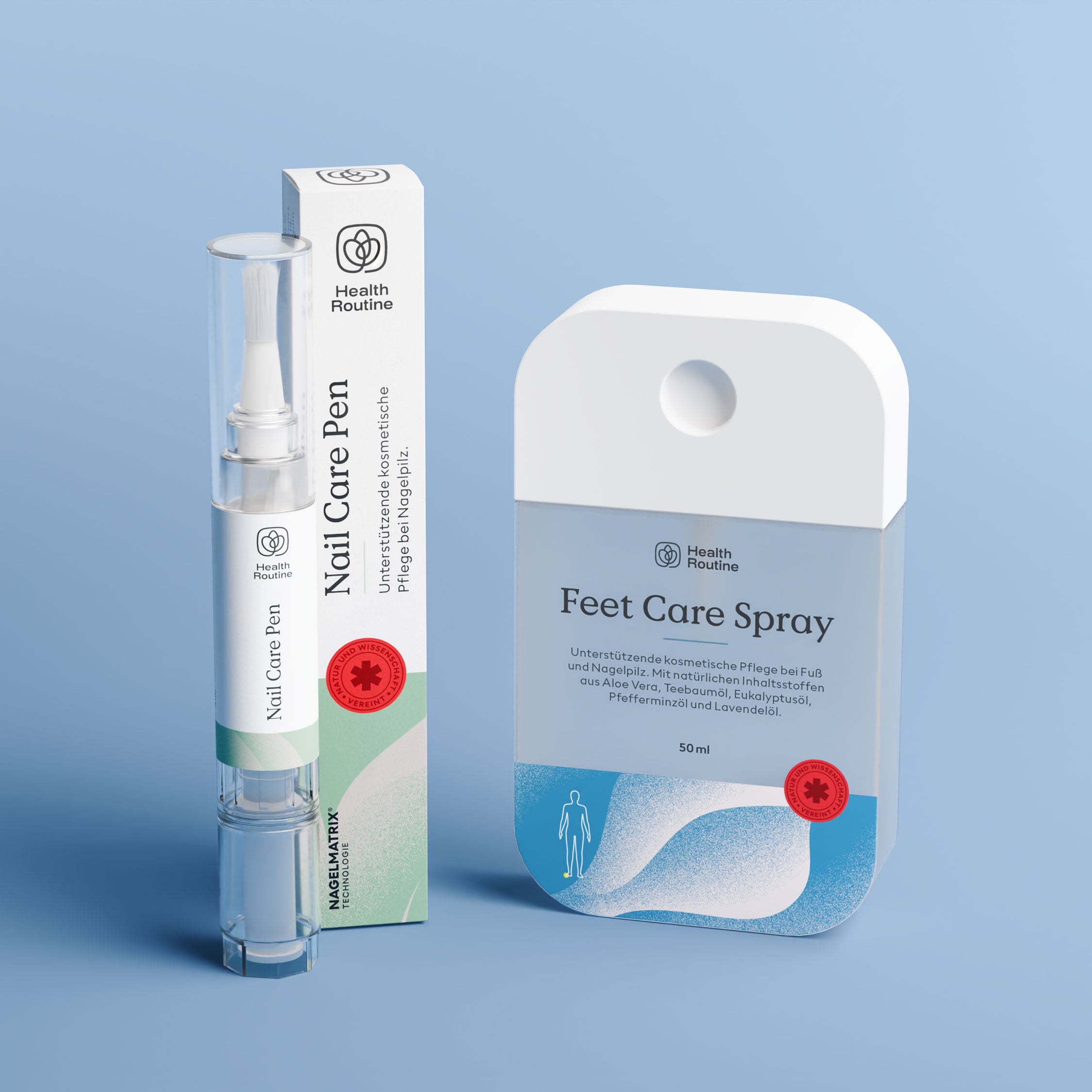The most important things at a glance
-
Nail fungus occurs more frequently in children than many people think – for example through swimming pools, tight shoes or familial infection.
-
The first symptoms are discoloration, thickening and brittle nails.
-
Timely treatment and good hygiene help prevent the spread.
-
Depending on the severity, local or systemic therapies may be considered – always under medical supervision.
Nail fungus in children: An underestimated topic
Imagine your child suddenly develops itchy, unpleasant changes on their toenails or fingernails. Could this possibly be nail fungus?
The fact is: Nail fungus is not uncommon among children! Therefore, it's a topic that affects many parents, but out of insecurity or shame, it's rarely discussed openly.
Children are fascinated by their diverse activities, be it
- while playing outdoors,
- at school
- or during sports, often come into contact with fungal spores.
But what happens if this contact actually results in nail fungus?

Which children are particularly vulnerable? These factors play a role
Not every child is equally susceptible to nail fungus. Various factors can increase the risk of nail fungus infection .
In this section you will learn which children are particularly at risk and why.
A family member with nail fungus: risk of infection
If someone in the family already has nail fungus, the risk of infection for children increases significantly.
Nail fungus is contagious and can easily be transmitted via shared items such as towels or floor mats.
Especially in a close family environment where physical contact is frequent, parents should pay attention to hygiene and take preventive measures to prevent the spread of the fungus.
Pflegt auch kosmetisch bei Nagelpilzinfektion Spendet Feuchtigkeit & regeneriert Schützt & stärkt die Nägel
Nail fungus in athletic children
Children who participate in sports activities are often at a higher risk for nail fungus. Wearing athletic shoes and frequent sweating create a warm, humid environment that provides ideal conditions for fungal spores to grow.
It is important that athletic children air their feet regularly, maintain good hygiene and wear dry socks .
In this way, the risk of a fungal infection can be reduced.
Concerns about frequent swimming pool visits
Swimming pools are real hotspots for athlete's foot and nail fungus, as fungal spores thrive in moist environments. Children who swim regularly should therefore exercise special caution.
Wearing bathing shoes and drying your feet thoroughly after swimming are simple but effective measures to reduce the risk of infection.
Certain diseases can increase the risk of nail fungus in children
Certain health conditions, such as a weakened immune system or other skin conditions such as atopic dermatitis , can make children more susceptible to nail fungus.
Parents should pay attention to their children's general health and skin care and consult a doctor if signs of skin problems occur. Early treatment can reduce the risk of fungal nail infections.

Treatment for fungal infections: What really helps?
When it comes to treating nail fungus in children, several options are available . It's important to choose a method that is effective while also being gentle on children's sensitive skin.
In the following sections you will learn more about the treatment options for nail fungus.
How is nail fungus treated in children?
Treating nail fungus in children should always be done carefully and with consideration for their sensitive skin. In most cases , treatment begins with topical antifungals , which are special creams or varnishes that are effective against nail fungus and are applied directly to the affected nail. These medications work locally and are generally well tolerated by children.
It is important to continue treatment consistently and not to stop prematurely, even if symptoms subside.
In addition to treating the nail fungus directly, good foot and nail hygiene is crucial. This includes regularly cleaning and drying the feet and trimming the nails to prevent re-infection.
In some cases, the use of antifungal foot powders or shoe sprays may also be recommended to minimize the risk of re-infection.
What are the benefits of systemic therapy for children?
Systemic therapy is a treatment used for more severe cases of nail fungus in children , especially when the child has a weakened immune system .
Simply put, systemic therapy means taking medications that work throughout the body. These medications fight the fungus from within.
They are usually prescribed by a doctor and are often the best choice when the nail fungus has already spread over a larger area or when external treatments with creams or lotions are no longer effective.
With systemic therapy, it is crucial to follow the doctor's instructions carefully and be aware of possible side effects. This form of treatment can be very effective against nail fungus, but it requires careful monitoring and must be tailored to the child's individual needs.
Expert tips: What can you do about nail fungus in children?
Nail fungus, especially in children, can be a challenge, but with the right tips and tricks you have the opportunity to effectively prevent and treat it.
Here are some expert tips that can help you get nail fungus under control in your child:
-
Hygiene is key: Make sure your child washes and dries their feet regularly, especially between the toes.
-
Separate towels and floor mats: Use separate towels and floor mats for your child to prevent the spread of the fungus.
-
Airy and dry shoes: Make sure your child wears breathable shoes and change them regularly to avoid moisture.
- Regular nail checks: Check your child's nails regularly for signs of nail fungus.

Why regular nail care is important for children
Regular nail care is an essential part of children's health and hygiene. It helps prevent nail fungus and other infections .
By keeping your child's nails clean and trimming them regularly, you prevent dirt and bacteria from accumulating in the first place.
In addition, regular checks allow you to detect nail discoloration or other changes early and take appropriate action.
Good nail care is therefore crucial to promote and protect the health of your child's hands and feet.
Nail fungus in children: Symptoms & first signs at a glance
Nail fungus in children can be easily overlooked because the symptoms are often subtle at first. It's important to recognize the early signs to enable quick and effective treatment.
Here are the most common symptoms of nail fungus in children to look out for:
-
Discoloration of the nail: The nail may appear yellowish, brown or whitish.
-
Nail thickening: The affected nail may be thicker and harder to cut.
-
Crumbling and brittle nails : The nail may become brittle and crumble at the edges.
-
Change in nail shape: The nail may become deformed or lift from the nail bed.
- Itching or discomfort: The child may report itching or discomfort in the area of the affected nail.
Why is the number of infections in childhood increasing?
The increase in fungal infections in childhood can be explained by several factors.
First , children's immune systems are still developing and therefore less effective at fighting infections, including fungal infections.
Secondly, the frequent use of community facilities such as schools, sports clubs and swimming pools leads to increased contact with fungal spores.
Thirdly, children often wear tight and synthetic footwear, which creates an ideal environment for the growth of fungi.
In addition, awareness of the importance of regular foot and nail care is often not yet sufficiently developed among children and their parents.
This combination of factors leads to an increased susceptibility to fungal infections in children.
Conclusion
Nail fungus in children is more than just a minor problem – it affects their health and well-being.
Through conscious action and prevention, we can help ensure that our children maintain healthy feet and nails.
Prevention and early treatment are important. Careful hygiene and keeping feet dry can also help keep nails healthy and well-maintained.
With the right information and appropriate tools, we can effectively control nail fungus and help our children enjoy their childhood without worries.
FAQ
Can nail fungus be treated without a doctor?
In mild cases, nail fungus can often be treated with over-the-counter medications.
However, it is important to correctly recognize the symptoms and to consult a doctor if you are unsure or if there is no improvement.
Self-treatment should always be done with caution and taking into account the specific needs of the child.
When should you see a doctor about nail fungus?
A visit to the doctor is advisable if the symptoms of nail fungus do not subside despite self-treatment, worsen or recur frequently.
If symptoms are severe, the infection is spreading, or if the child has a weakened immune system, medical advice is essential.
Is nail fungus contagious in children?
Yes, nail fungus is contagious and can easily be transmitted from child to child.
It can be transmitted through direct contact with infected surfaces or through the exchange of personal items such as towels and shoes.
Especially in families with several children, caution is required to prevent the spread of the fungus.
Therefore, it is important to practice good hygiene measures and act quickly in the event of a fungal infection.
🌿 Discover more guides from Health Routine now:
- Treating nail fungus: symptoms, remedies and tips
- Healthy Nails » Tips for stronger and beautiful nails
- Nail changes » All about symptoms & treatment ✓
- Foot bath with salt » Benefits & expert tips at a glance!
- Caring for your feet: Expert tips for optimal foot care
Your medical advice
Our products are not intended to diagnose, treat, cure, or prevent any disease. The information provided in this article is for informational purposes only and is not intended as a substitute for advice from your physician or other healthcare professional.
Furthermore, our products are not a substitute for medications or other treatments prescribed by your doctor or healthcare provider. Regardless of the due care taken, no liability or warranty is assumed for the
- Accuracy,
- topicality,
- completeness
- and availability of the information provided.
No legal claims can be made for any damages potentially resulting from the use and application of this information. Liability claims of any kind are excluded.






